Understanding Toyota's Operations, Logistics, Supply Chain Management
VerifiedAdded on 2020/10/23
|12
|3181
|148
Report
AI Summary
This report provides a detailed analysis of Toyota's operations, logistics, and supply chain management. It explores key concepts such as operation management, logistic management, and supply chain management, referencing Toyota's practices as a case study. The report delves into quality management strategies, including total quality management, Six Sigma, just-in-time inventory, and benchmarking, and their application within Toyota. It further examines new product and service development procedures, outlining stages from idea generation to commercialization. The report also discusses the triple bottom line framework and offers recommendations for business improvement within Toyota's context. The report covers a comprehensive range of topics within supply chain management, quality control, and product development, with a focus on strategic approaches for organizational improvement.
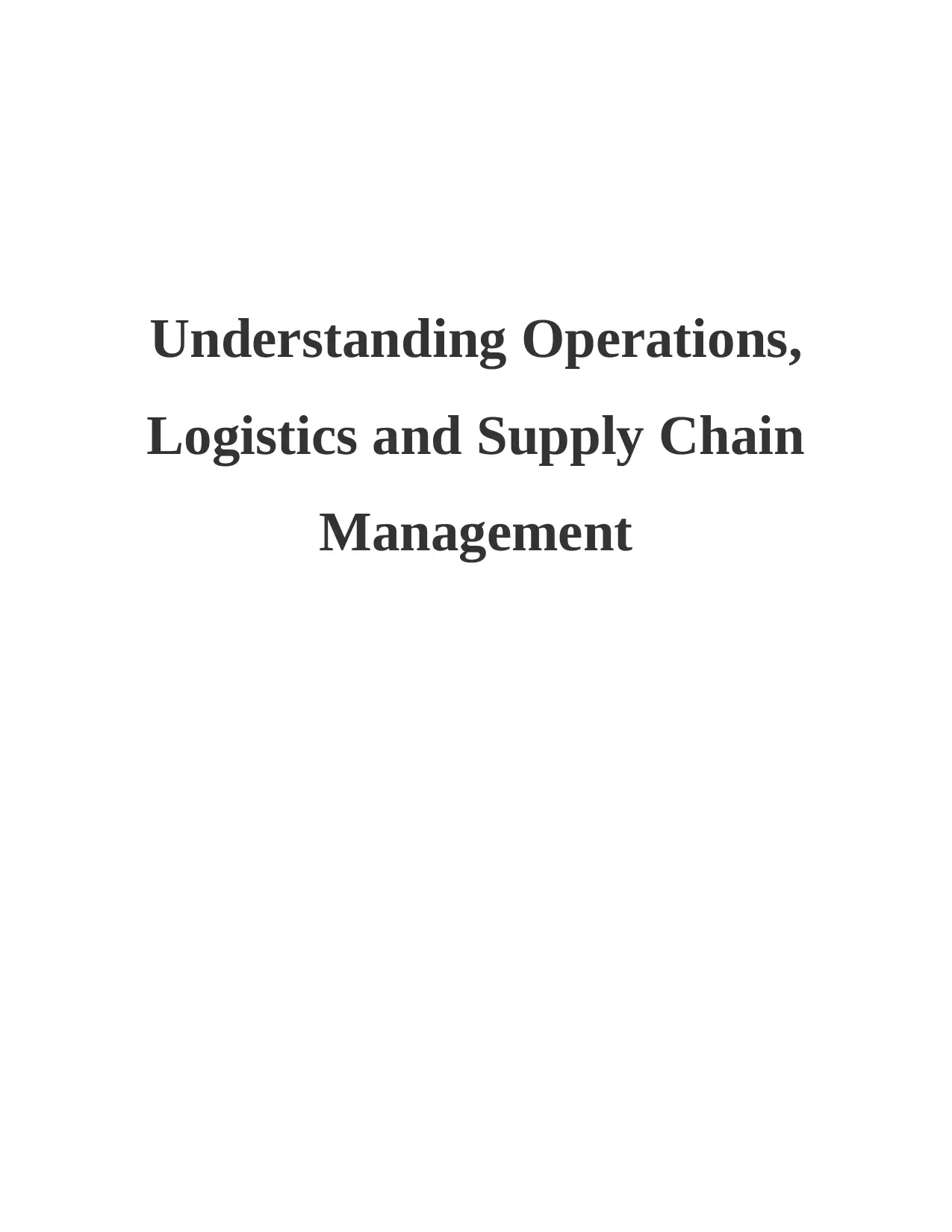
Understanding Operations,
Logistics and Supply Chain
Management
Logistics and Supply Chain
Management
Paraphrase This Document
Need a fresh take? Get an instant paraphrase of this document with our AI Paraphraser
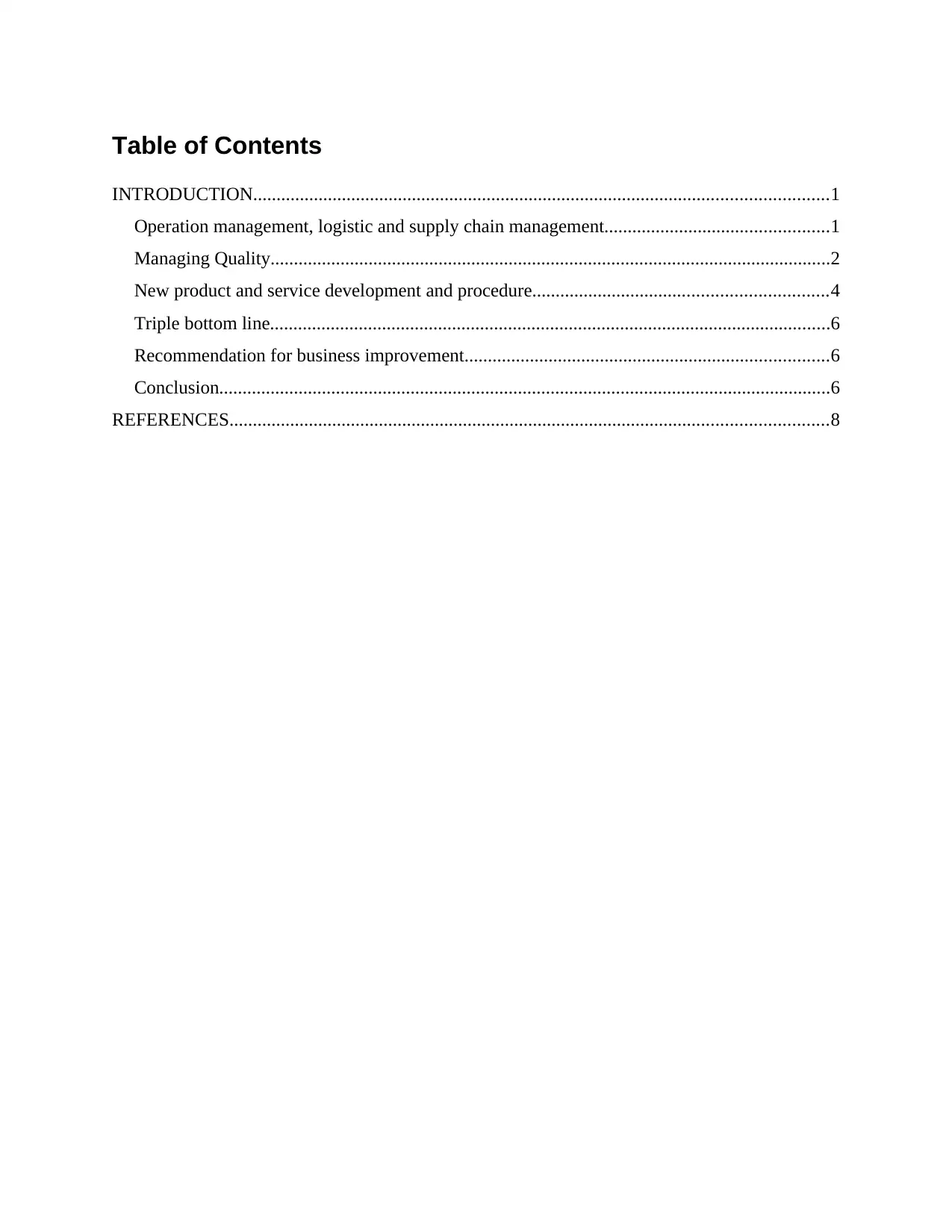
Table of Contents
INTRODUCTION...........................................................................................................................1
Operation management, logistic and supply chain management................................................1
Managing Quality........................................................................................................................2
New product and service development and procedure...............................................................4
Triple bottom line........................................................................................................................6
Recommendation for business improvement..............................................................................6
Conclusion...................................................................................................................................6
REFERENCES................................................................................................................................8
INTRODUCTION...........................................................................................................................1
Operation management, logistic and supply chain management................................................1
Managing Quality........................................................................................................................2
New product and service development and procedure...............................................................4
Triple bottom line........................................................................................................................6
Recommendation for business improvement..............................................................................6
Conclusion...................................................................................................................................6
REFERENCES................................................................................................................................8
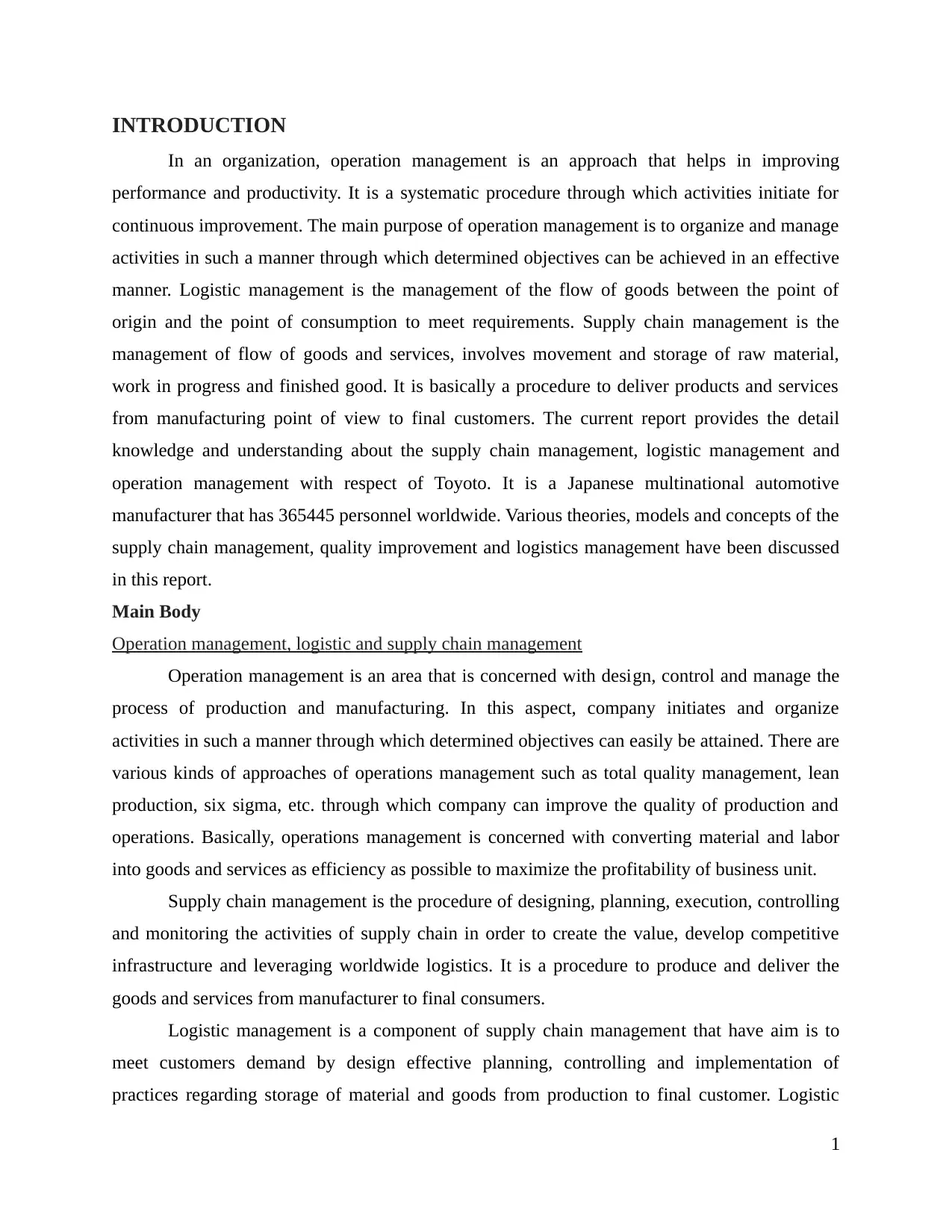
INTRODUCTION
In an organization, operation management is an approach that helps in improving
performance and productivity. It is a systematic procedure through which activities initiate for
continuous improvement. The main purpose of operation management is to organize and manage
activities in such a manner through which determined objectives can be achieved in an effective
manner. Logistic management is the management of the flow of goods between the point of
origin and the point of consumption to meet requirements. Supply chain management is the
management of flow of goods and services, involves movement and storage of raw material,
work in progress and finished good. It is basically a procedure to deliver products and services
from manufacturing point of view to final customers. The current report provides the detail
knowledge and understanding about the supply chain management, logistic management and
operation management with respect of Toyoto. It is a Japanese multinational automotive
manufacturer that has 365445 personnel worldwide. Various theories, models and concepts of the
supply chain management, quality improvement and logistics management have been discussed
in this report.
Main Body
Operation management, logistic and supply chain management
Operation management is an area that is concerned with design, control and manage the
process of production and manufacturing. In this aspect, company initiates and organize
activities in such a manner through which determined objectives can easily be attained. There are
various kinds of approaches of operations management such as total quality management, lean
production, six sigma, etc. through which company can improve the quality of production and
operations. Basically, operations management is concerned with converting material and labor
into goods and services as efficiency as possible to maximize the profitability of business unit.
Supply chain management is the procedure of designing, planning, execution, controlling
and monitoring the activities of supply chain in order to create the value, develop competitive
infrastructure and leveraging worldwide logistics. It is a procedure to produce and deliver the
goods and services from manufacturer to final consumers.
Logistic management is a component of supply chain management that have aim is to
meet customers demand by design effective planning, controlling and implementation of
practices regarding storage of material and goods from production to final customer. Logistic
1
In an organization, operation management is an approach that helps in improving
performance and productivity. It is a systematic procedure through which activities initiate for
continuous improvement. The main purpose of operation management is to organize and manage
activities in such a manner through which determined objectives can be achieved in an effective
manner. Logistic management is the management of the flow of goods between the point of
origin and the point of consumption to meet requirements. Supply chain management is the
management of flow of goods and services, involves movement and storage of raw material,
work in progress and finished good. It is basically a procedure to deliver products and services
from manufacturing point of view to final customers. The current report provides the detail
knowledge and understanding about the supply chain management, logistic management and
operation management with respect of Toyoto. It is a Japanese multinational automotive
manufacturer that has 365445 personnel worldwide. Various theories, models and concepts of the
supply chain management, quality improvement and logistics management have been discussed
in this report.
Main Body
Operation management, logistic and supply chain management
Operation management is an area that is concerned with design, control and manage the
process of production and manufacturing. In this aspect, company initiates and organize
activities in such a manner through which determined objectives can easily be attained. There are
various kinds of approaches of operations management such as total quality management, lean
production, six sigma, etc. through which company can improve the quality of production and
operations. Basically, operations management is concerned with converting material and labor
into goods and services as efficiency as possible to maximize the profitability of business unit.
Supply chain management is the procedure of designing, planning, execution, controlling
and monitoring the activities of supply chain in order to create the value, develop competitive
infrastructure and leveraging worldwide logistics. It is a procedure to produce and deliver the
goods and services from manufacturer to final consumers.
Logistic management is a component of supply chain management that have aim is to
meet customers demand by design effective planning, controlling and implementation of
practices regarding storage of material and goods from production to final customer. Logistic
1
⊘ This is a preview!⊘
Do you want full access?
Subscribe today to unlock all pages.

Trusted by 1+ million students worldwide
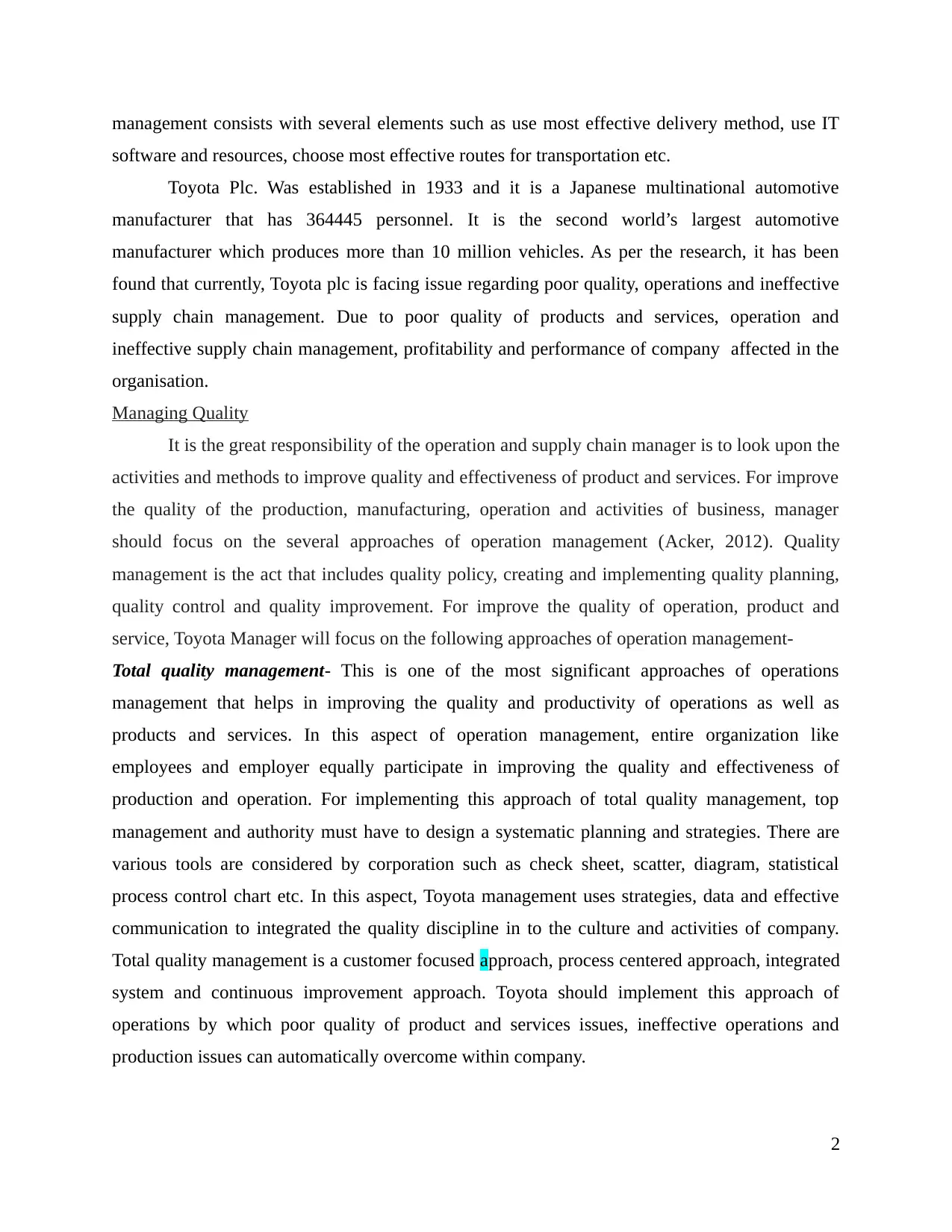
management consists with several elements such as use most effective delivery method, use IT
software and resources, choose most effective routes for transportation etc.
Toyota Plc. Was established in 1933 and it is a Japanese multinational automotive
manufacturer that has 364445 personnel. It is the second world’s largest automotive
manufacturer which produces more than 10 million vehicles. As per the research, it has been
found that currently, Toyota plc is facing issue regarding poor quality, operations and ineffective
supply chain management. Due to poor quality of products and services, operation and
ineffective supply chain management, profitability and performance of company affected in the
organisation.
Managing Quality
It is the great responsibility of the operation and supply chain manager is to look upon the
activities and methods to improve quality and effectiveness of product and services. For improve
the quality of the production, manufacturing, operation and activities of business, manager
should focus on the several approaches of operation management (Acker, 2012). Quality
management is the act that includes quality policy, creating and implementing quality planning,
quality control and quality improvement. For improve the quality of operation, product and
service, Toyota Manager will focus on the following approaches of operation management-
Total quality management- This is one of the most significant approaches of operations
management that helps in improving the quality and productivity of operations as well as
products and services. In this aspect of operation management, entire organization like
employees and employer equally participate in improving the quality and effectiveness of
production and operation. For implementing this approach of total quality management, top
management and authority must have to design a systematic planning and strategies. There are
various tools are considered by corporation such as check sheet, scatter, diagram, statistical
process control chart etc. In this aspect, Toyota management uses strategies, data and effective
communication to integrated the quality discipline in to the culture and activities of company.
Total quality management is a customer focused approach, process centered approach, integrated
system and continuous improvement approach. Toyota should implement this approach of
operations by which poor quality of product and services issues, ineffective operations and
production issues can automatically overcome within company.
2
software and resources, choose most effective routes for transportation etc.
Toyota Plc. Was established in 1933 and it is a Japanese multinational automotive
manufacturer that has 364445 personnel. It is the second world’s largest automotive
manufacturer which produces more than 10 million vehicles. As per the research, it has been
found that currently, Toyota plc is facing issue regarding poor quality, operations and ineffective
supply chain management. Due to poor quality of products and services, operation and
ineffective supply chain management, profitability and performance of company affected in the
organisation.
Managing Quality
It is the great responsibility of the operation and supply chain manager is to look upon the
activities and methods to improve quality and effectiveness of product and services. For improve
the quality of the production, manufacturing, operation and activities of business, manager
should focus on the several approaches of operation management (Acker, 2012). Quality
management is the act that includes quality policy, creating and implementing quality planning,
quality control and quality improvement. For improve the quality of operation, product and
service, Toyota Manager will focus on the following approaches of operation management-
Total quality management- This is one of the most significant approaches of operations
management that helps in improving the quality and productivity of operations as well as
products and services. In this aspect of operation management, entire organization like
employees and employer equally participate in improving the quality and effectiveness of
production and operation. For implementing this approach of total quality management, top
management and authority must have to design a systematic planning and strategies. There are
various tools are considered by corporation such as check sheet, scatter, diagram, statistical
process control chart etc. In this aspect, Toyota management uses strategies, data and effective
communication to integrated the quality discipline in to the culture and activities of company.
Total quality management is a customer focused approach, process centered approach, integrated
system and continuous improvement approach. Toyota should implement this approach of
operations by which poor quality of product and services issues, ineffective operations and
production issues can automatically overcome within company.
2
Paraphrase This Document
Need a fresh take? Get an instant paraphrase of this document with our AI Paraphraser
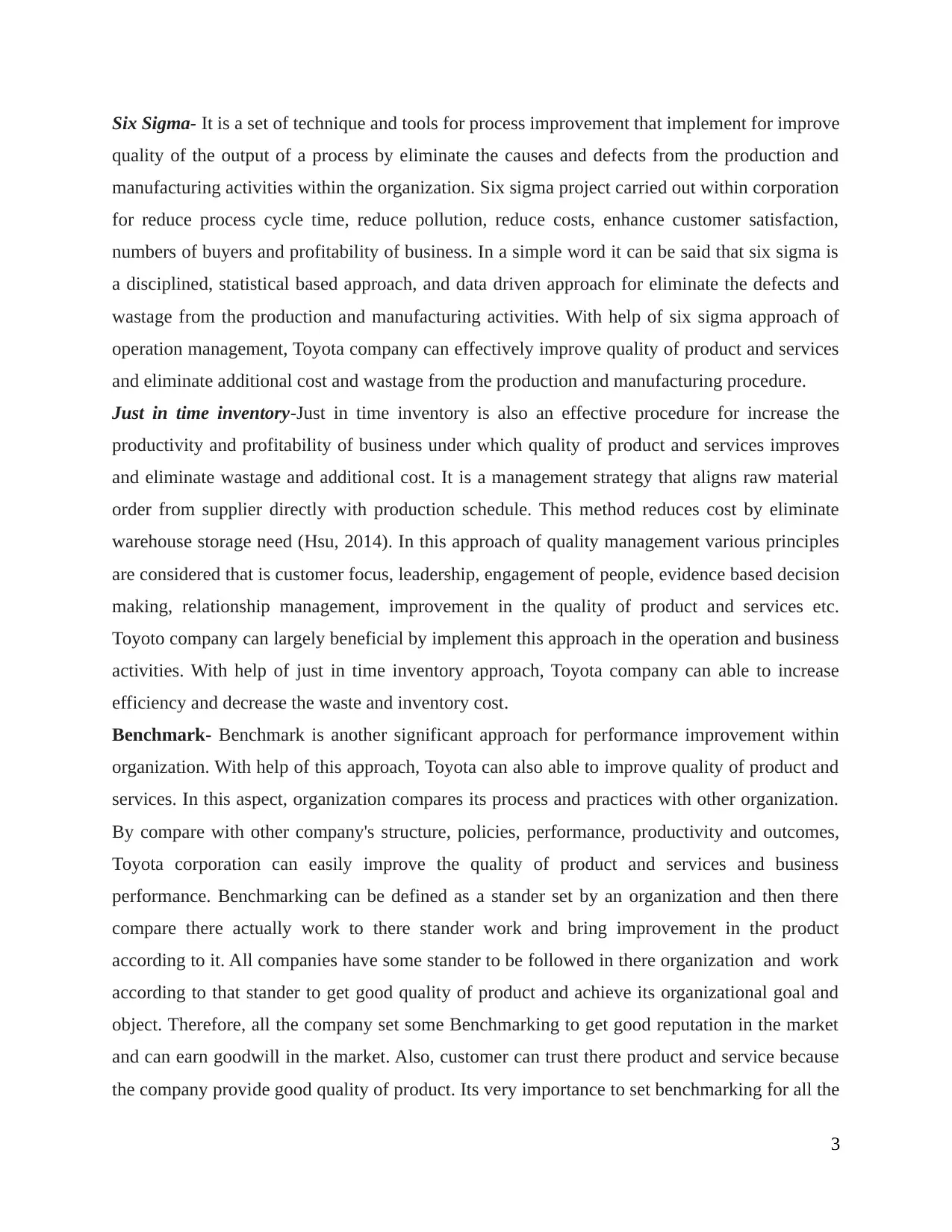
Six Sigma- It is a set of technique and tools for process improvement that implement for improve
quality of the output of a process by eliminate the causes and defects from the production and
manufacturing activities within the organization. Six sigma project carried out within corporation
for reduce process cycle time, reduce pollution, reduce costs, enhance customer satisfaction,
numbers of buyers and profitability of business. In a simple word it can be said that six sigma is
a disciplined, statistical based approach, and data driven approach for eliminate the defects and
wastage from the production and manufacturing activities. With help of six sigma approach of
operation management, Toyota company can effectively improve quality of product and services
and eliminate additional cost and wastage from the production and manufacturing procedure.
Just in time inventory-Just in time inventory is also an effective procedure for increase the
productivity and profitability of business under which quality of product and services improves
and eliminate wastage and additional cost. It is a management strategy that aligns raw material
order from supplier directly with production schedule. This method reduces cost by eliminate
warehouse storage need (Hsu, 2014). In this approach of quality management various principles
are considered that is customer focus, leadership, engagement of people, evidence based decision
making, relationship management, improvement in the quality of product and services etc.
Toyoto company can largely beneficial by implement this approach in the operation and business
activities. With help of just in time inventory approach, Toyota company can able to increase
efficiency and decrease the waste and inventory cost.
Benchmark- Benchmark is another significant approach for performance improvement within
organization. With help of this approach, Toyota can also able to improve quality of product and
services. In this aspect, organization compares its process and practices with other organization.
By compare with other company's structure, policies, performance, productivity and outcomes,
Toyota corporation can easily improve the quality of product and services and business
performance. Benchmarking can be defined as a stander set by an organization and then there
compare there actually work to there stander work and bring improvement in the product
according to it. All companies have some stander to be followed in there organization and work
according to that stander to get good quality of product and achieve its organizational goal and
object. Therefore, all the company set some Benchmarking to get good reputation in the market
and can earn goodwill in the market. Also, customer can trust there product and service because
the company provide good quality of product. Its very importance to set benchmarking for all the
3
quality of the output of a process by eliminate the causes and defects from the production and
manufacturing activities within the organization. Six sigma project carried out within corporation
for reduce process cycle time, reduce pollution, reduce costs, enhance customer satisfaction,
numbers of buyers and profitability of business. In a simple word it can be said that six sigma is
a disciplined, statistical based approach, and data driven approach for eliminate the defects and
wastage from the production and manufacturing activities. With help of six sigma approach of
operation management, Toyota company can effectively improve quality of product and services
and eliminate additional cost and wastage from the production and manufacturing procedure.
Just in time inventory-Just in time inventory is also an effective procedure for increase the
productivity and profitability of business under which quality of product and services improves
and eliminate wastage and additional cost. It is a management strategy that aligns raw material
order from supplier directly with production schedule. This method reduces cost by eliminate
warehouse storage need (Hsu, 2014). In this approach of quality management various principles
are considered that is customer focus, leadership, engagement of people, evidence based decision
making, relationship management, improvement in the quality of product and services etc.
Toyoto company can largely beneficial by implement this approach in the operation and business
activities. With help of just in time inventory approach, Toyota company can able to increase
efficiency and decrease the waste and inventory cost.
Benchmark- Benchmark is another significant approach for performance improvement within
organization. With help of this approach, Toyota can also able to improve quality of product and
services. In this aspect, organization compares its process and practices with other organization.
By compare with other company's structure, policies, performance, productivity and outcomes,
Toyota corporation can easily improve the quality of product and services and business
performance. Benchmarking can be defined as a stander set by an organization and then there
compare there actually work to there stander work and bring improvement in the product
according to it. All companies have some stander to be followed in there organization and work
according to that stander to get good quality of product and achieve its organizational goal and
object. Therefore, all the company set some Benchmarking to get good reputation in the market
and can earn goodwill in the market. Also, customer can trust there product and service because
the company provide good quality of product. Its very importance to set benchmarking for all the
3
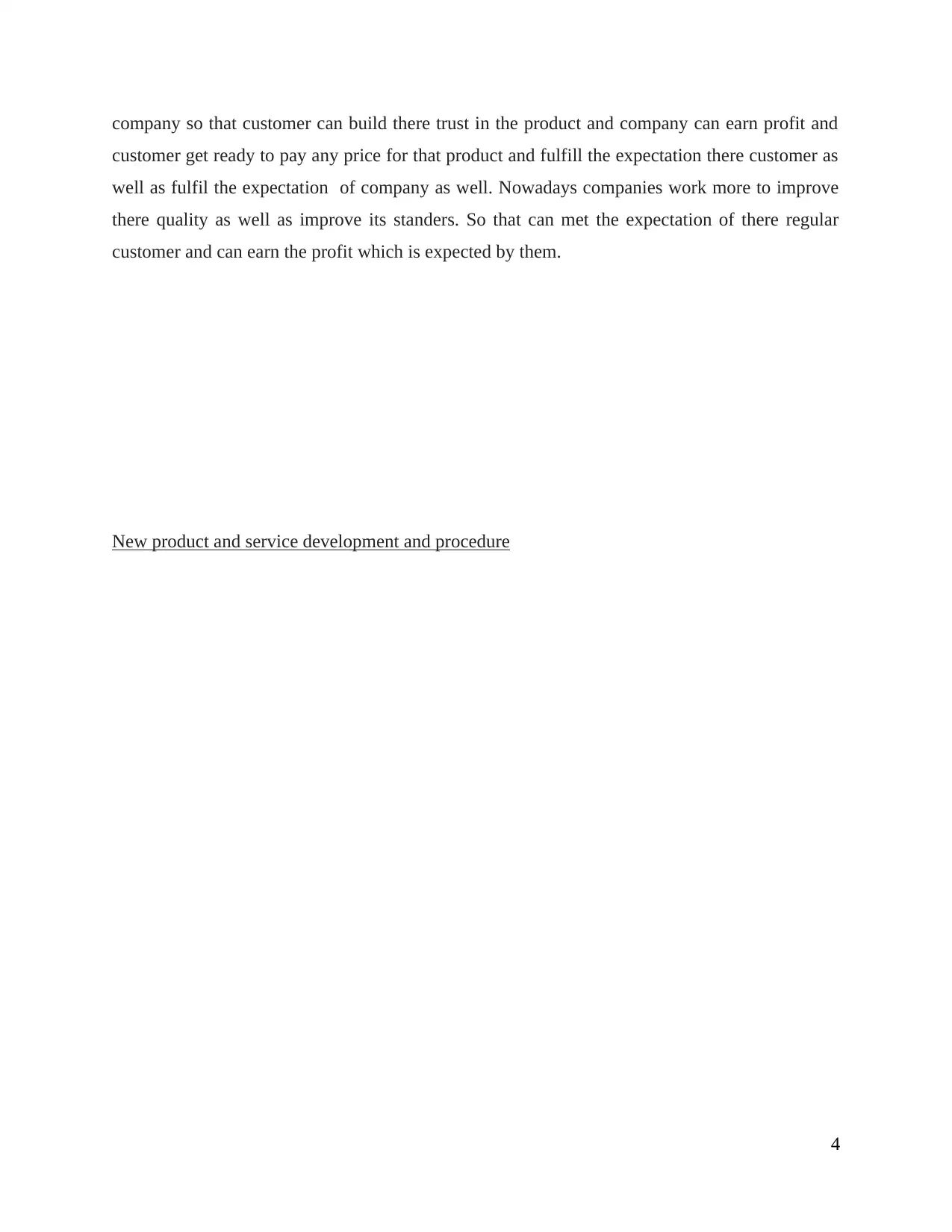
company so that customer can build there trust in the product and company can earn profit and
customer get ready to pay any price for that product and fulfill the expectation there customer as
well as fulfil the expectation of company as well. Nowadays companies work more to improve
there quality as well as improve its standers. So that can met the expectation of there regular
customer and can earn the profit which is expected by them.
New product and service development and procedure
4
customer get ready to pay any price for that product and fulfill the expectation there customer as
well as fulfil the expectation of company as well. Nowadays companies work more to improve
there quality as well as improve its standers. So that can met the expectation of there regular
customer and can earn the profit which is expected by them.
New product and service development and procedure
4
⊘ This is a preview!⊘
Do you want full access?
Subscribe today to unlock all pages.

Trusted by 1+ million students worldwide
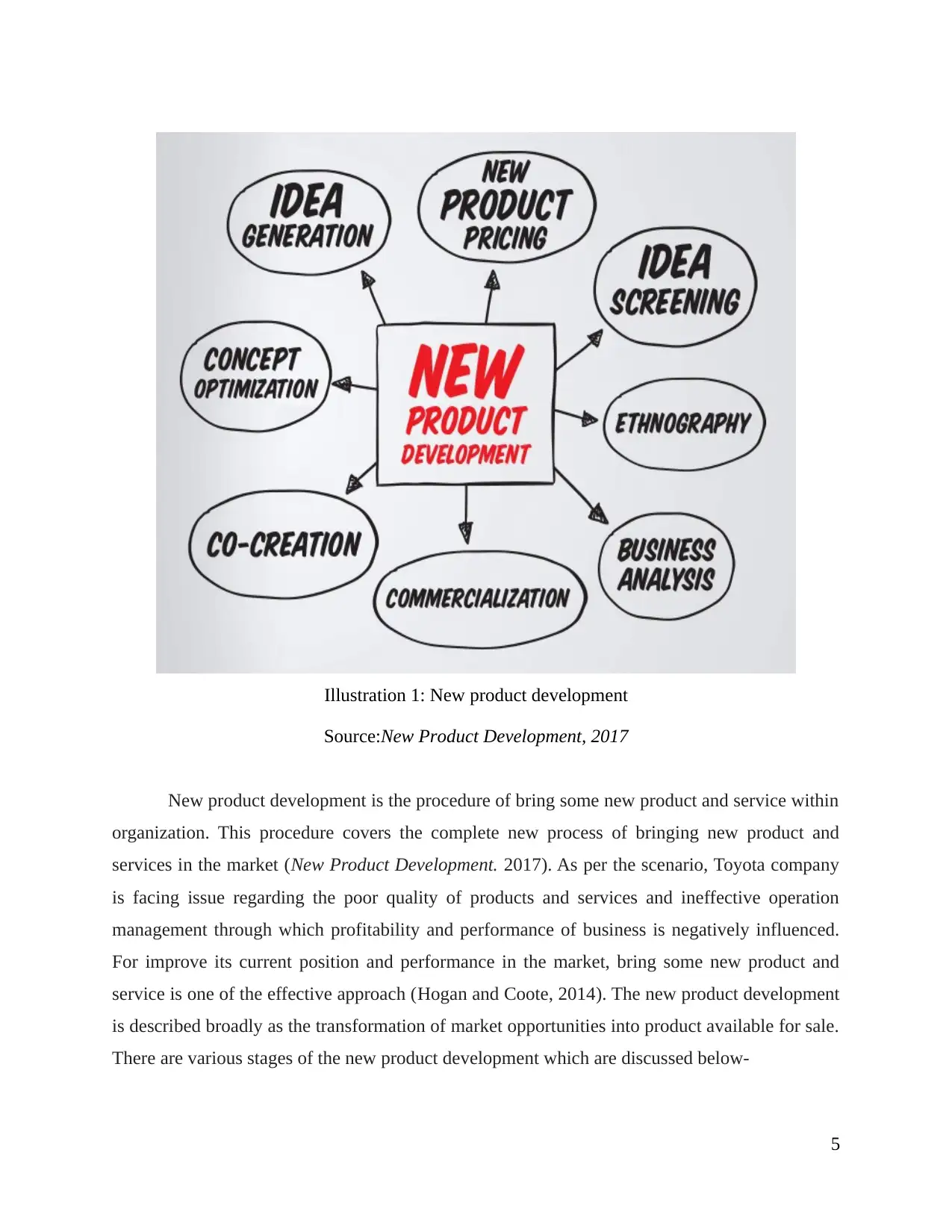
New product development is the procedure of bring some new product and service within
organization. This procedure covers the complete new process of bringing new product and
services in the market (New Product Development. 2017). As per the scenario, Toyota company
is facing issue regarding the poor quality of products and services and ineffective operation
management through which profitability and performance of business is negatively influenced.
For improve its current position and performance in the market, bring some new product and
service is one of the effective approach (Hogan and Coote, 2014). The new product development
is described broadly as the transformation of market opportunities into product available for sale.
There are various stages of the new product development which are discussed below-
5
Illustration 1: New product development
Source:New Product Development, 2017
organization. This procedure covers the complete new process of bringing new product and
services in the market (New Product Development. 2017). As per the scenario, Toyota company
is facing issue regarding the poor quality of products and services and ineffective operation
management through which profitability and performance of business is negatively influenced.
For improve its current position and performance in the market, bring some new product and
service is one of the effective approach (Hogan and Coote, 2014). The new product development
is described broadly as the transformation of market opportunities into product available for sale.
There are various stages of the new product development which are discussed below-
5
Illustration 1: New product development
Source:New Product Development, 2017
Paraphrase This Document
Need a fresh take? Get an instant paraphrase of this document with our AI Paraphraser
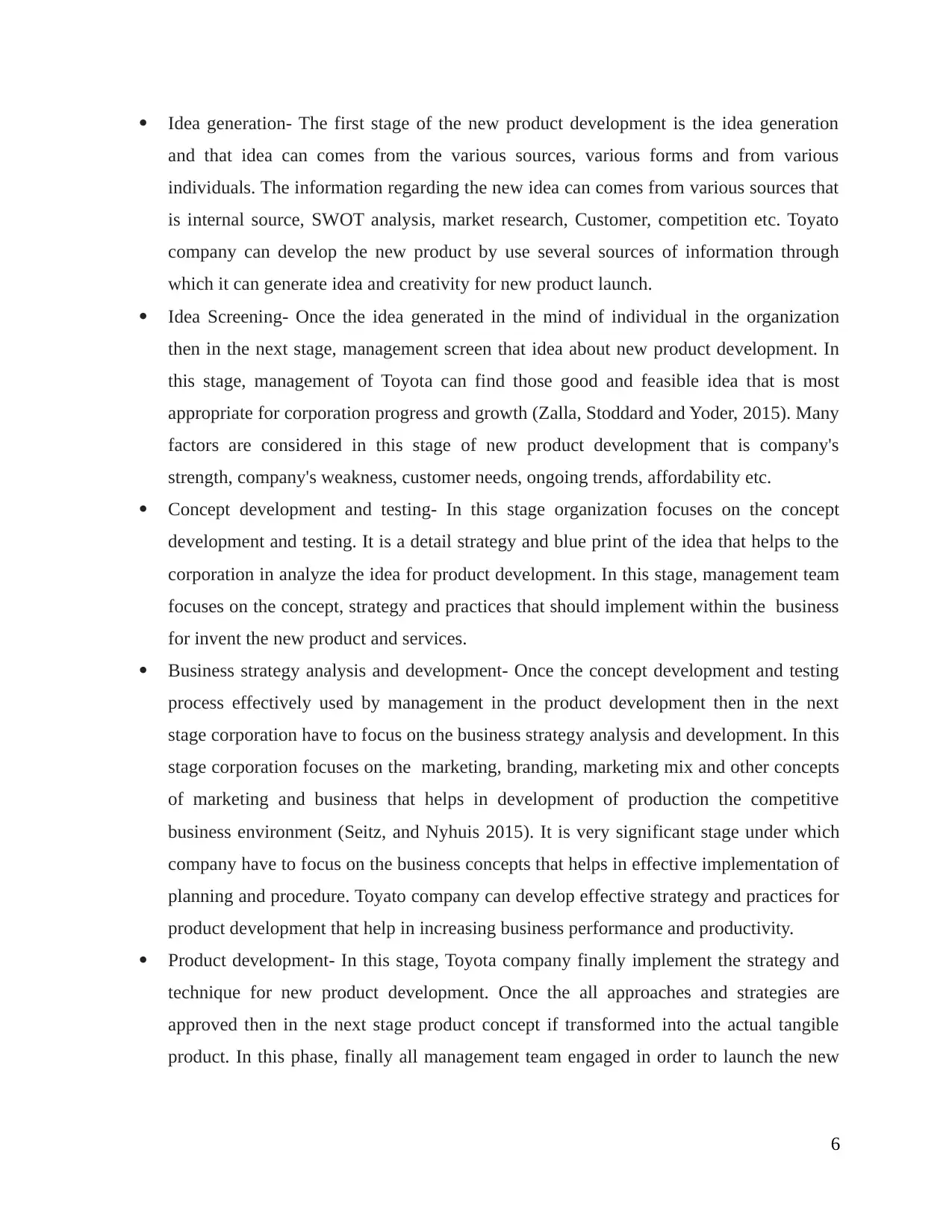
Idea generation- The first stage of the new product development is the idea generation
and that idea can comes from the various sources, various forms and from various
individuals. The information regarding the new idea can comes from various sources that
is internal source, SWOT analysis, market research, Customer, competition etc. Toyato
company can develop the new product by use several sources of information through
which it can generate idea and creativity for new product launch.
Idea Screening- Once the idea generated in the mind of individual in the organization
then in the next stage, management screen that idea about new product development. In
this stage, management of Toyota can find those good and feasible idea that is most
appropriate for corporation progress and growth (Zalla, Stoddard and Yoder, 2015). Many
factors are considered in this stage of new product development that is company's
strength, company's weakness, customer needs, ongoing trends, affordability etc.
Concept development and testing- In this stage organization focuses on the concept
development and testing. It is a detail strategy and blue print of the idea that helps to the
corporation in analyze the idea for product development. In this stage, management team
focuses on the concept, strategy and practices that should implement within the business
for invent the new product and services.
Business strategy analysis and development- Once the concept development and testing
process effectively used by management in the product development then in the next
stage corporation have to focus on the business strategy analysis and development. In this
stage corporation focuses on the marketing, branding, marketing mix and other concepts
of marketing and business that helps in development of production the competitive
business environment (Seitz, and Nyhuis 2015). It is very significant stage under which
company have to focus on the business concepts that helps in effective implementation of
planning and procedure. Toyato company can develop effective strategy and practices for
product development that help in increasing business performance and productivity.
Product development- In this stage, Toyota company finally implement the strategy and
technique for new product development. Once the all approaches and strategies are
approved then in the next stage product concept if transformed into the actual tangible
product. In this phase, finally all management team engaged in order to launch the new
6
and that idea can comes from the various sources, various forms and from various
individuals. The information regarding the new idea can comes from various sources that
is internal source, SWOT analysis, market research, Customer, competition etc. Toyato
company can develop the new product by use several sources of information through
which it can generate idea and creativity for new product launch.
Idea Screening- Once the idea generated in the mind of individual in the organization
then in the next stage, management screen that idea about new product development. In
this stage, management of Toyota can find those good and feasible idea that is most
appropriate for corporation progress and growth (Zalla, Stoddard and Yoder, 2015). Many
factors are considered in this stage of new product development that is company's
strength, company's weakness, customer needs, ongoing trends, affordability etc.
Concept development and testing- In this stage organization focuses on the concept
development and testing. It is a detail strategy and blue print of the idea that helps to the
corporation in analyze the idea for product development. In this stage, management team
focuses on the concept, strategy and practices that should implement within the business
for invent the new product and services.
Business strategy analysis and development- Once the concept development and testing
process effectively used by management in the product development then in the next
stage corporation have to focus on the business strategy analysis and development. In this
stage corporation focuses on the marketing, branding, marketing mix and other concepts
of marketing and business that helps in development of production the competitive
business environment (Seitz, and Nyhuis 2015). It is very significant stage under which
company have to focus on the business concepts that helps in effective implementation of
planning and procedure. Toyato company can develop effective strategy and practices for
product development that help in increasing business performance and productivity.
Product development- In this stage, Toyota company finally implement the strategy and
technique for new product development. Once the all approaches and strategies are
approved then in the next stage product concept if transformed into the actual tangible
product. In this phase, finally all management team engaged in order to launch the new
6
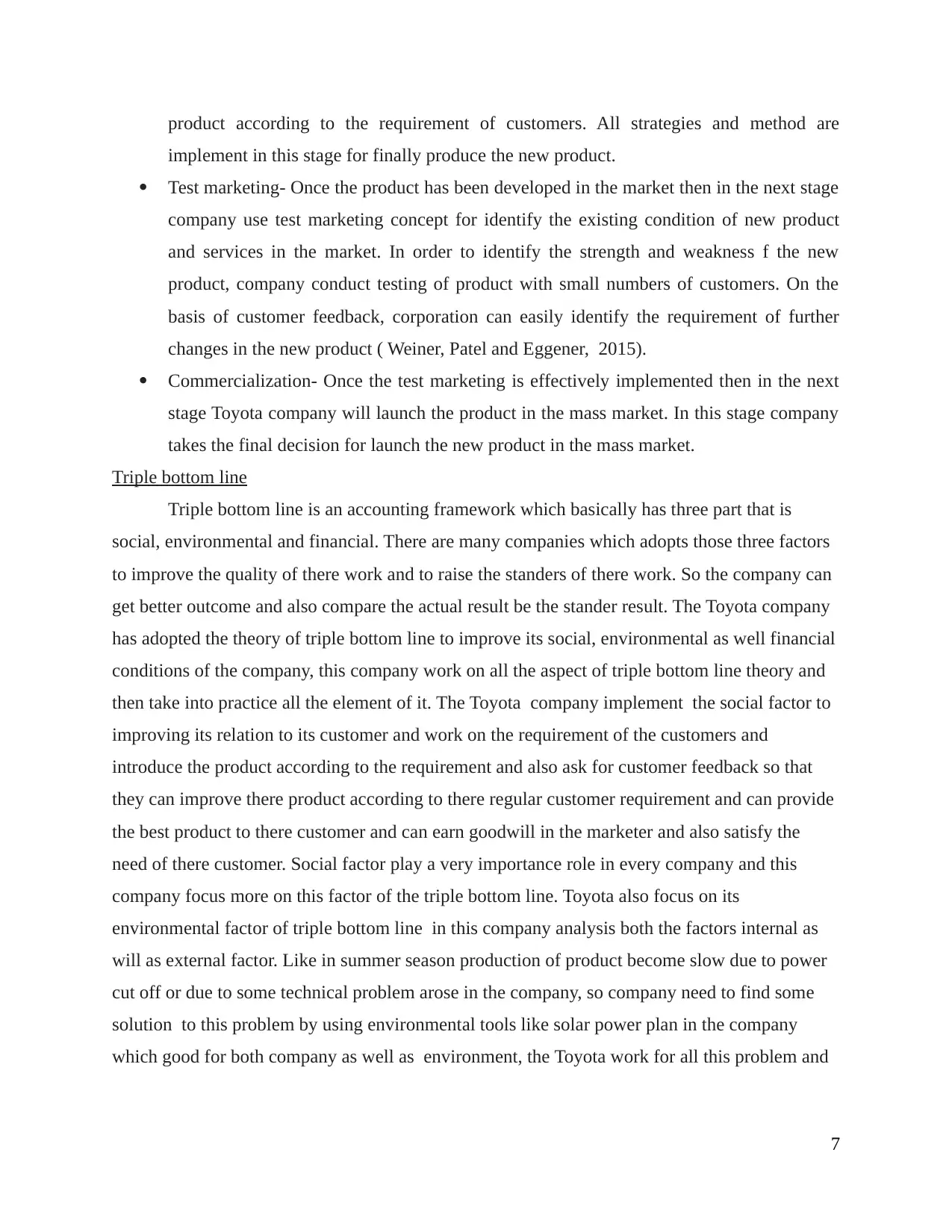
product according to the requirement of customers. All strategies and method are
implement in this stage for finally produce the new product.
Test marketing- Once the product has been developed in the market then in the next stage
company use test marketing concept for identify the existing condition of new product
and services in the market. In order to identify the strength and weakness f the new
product, company conduct testing of product with small numbers of customers. On the
basis of customer feedback, corporation can easily identify the requirement of further
changes in the new product ( Weiner, Patel and Eggener, 2015).
Commercialization- Once the test marketing is effectively implemented then in the next
stage Toyota company will launch the product in the mass market. In this stage company
takes the final decision for launch the new product in the mass market.
Triple bottom line
Triple bottom line is an accounting framework which basically has three part that is
social, environmental and financial. There are many companies which adopts those three factors
to improve the quality of there work and to raise the standers of there work. So the company can
get better outcome and also compare the actual result be the stander result. The Toyota company
has adopted the theory of triple bottom line to improve its social, environmental as well financial
conditions of the company, this company work on all the aspect of triple bottom line theory and
then take into practice all the element of it. The Toyota company implement the social factor to
improving its relation to its customer and work on the requirement of the customers and
introduce the product according to the requirement and also ask for customer feedback so that
they can improve there product according to there regular customer requirement and can provide
the best product to there customer and can earn goodwill in the marketer and also satisfy the
need of there customer. Social factor play a very importance role in every company and this
company focus more on this factor of the triple bottom line. Toyota also focus on its
environmental factor of triple bottom line in this company analysis both the factors internal as
will as external factor. Like in summer season production of product become slow due to power
cut off or due to some technical problem arose in the company, so company need to find some
solution to this problem by using environmental tools like solar power plan in the company
which good for both company as well as environment, the Toyota work for all this problem and
7
implement in this stage for finally produce the new product.
Test marketing- Once the product has been developed in the market then in the next stage
company use test marketing concept for identify the existing condition of new product
and services in the market. In order to identify the strength and weakness f the new
product, company conduct testing of product with small numbers of customers. On the
basis of customer feedback, corporation can easily identify the requirement of further
changes in the new product ( Weiner, Patel and Eggener, 2015).
Commercialization- Once the test marketing is effectively implemented then in the next
stage Toyota company will launch the product in the mass market. In this stage company
takes the final decision for launch the new product in the mass market.
Triple bottom line
Triple bottom line is an accounting framework which basically has three part that is
social, environmental and financial. There are many companies which adopts those three factors
to improve the quality of there work and to raise the standers of there work. So the company can
get better outcome and also compare the actual result be the stander result. The Toyota company
has adopted the theory of triple bottom line to improve its social, environmental as well financial
conditions of the company, this company work on all the aspect of triple bottom line theory and
then take into practice all the element of it. The Toyota company implement the social factor to
improving its relation to its customer and work on the requirement of the customers and
introduce the product according to the requirement and also ask for customer feedback so that
they can improve there product according to there regular customer requirement and can provide
the best product to there customer and can earn goodwill in the marketer and also satisfy the
need of there customer. Social factor play a very importance role in every company and this
company focus more on this factor of the triple bottom line. Toyota also focus on its
environmental factor of triple bottom line in this company analysis both the factors internal as
will as external factor. Like in summer season production of product become slow due to power
cut off or due to some technical problem arose in the company, so company need to find some
solution to this problem by using environmental tools like solar power plan in the company
which good for both company as well as environment, the Toyota work for all this problem and
7
⊘ This is a preview!⊘
Do you want full access?
Subscribe today to unlock all pages.

Trusted by 1+ million students worldwide
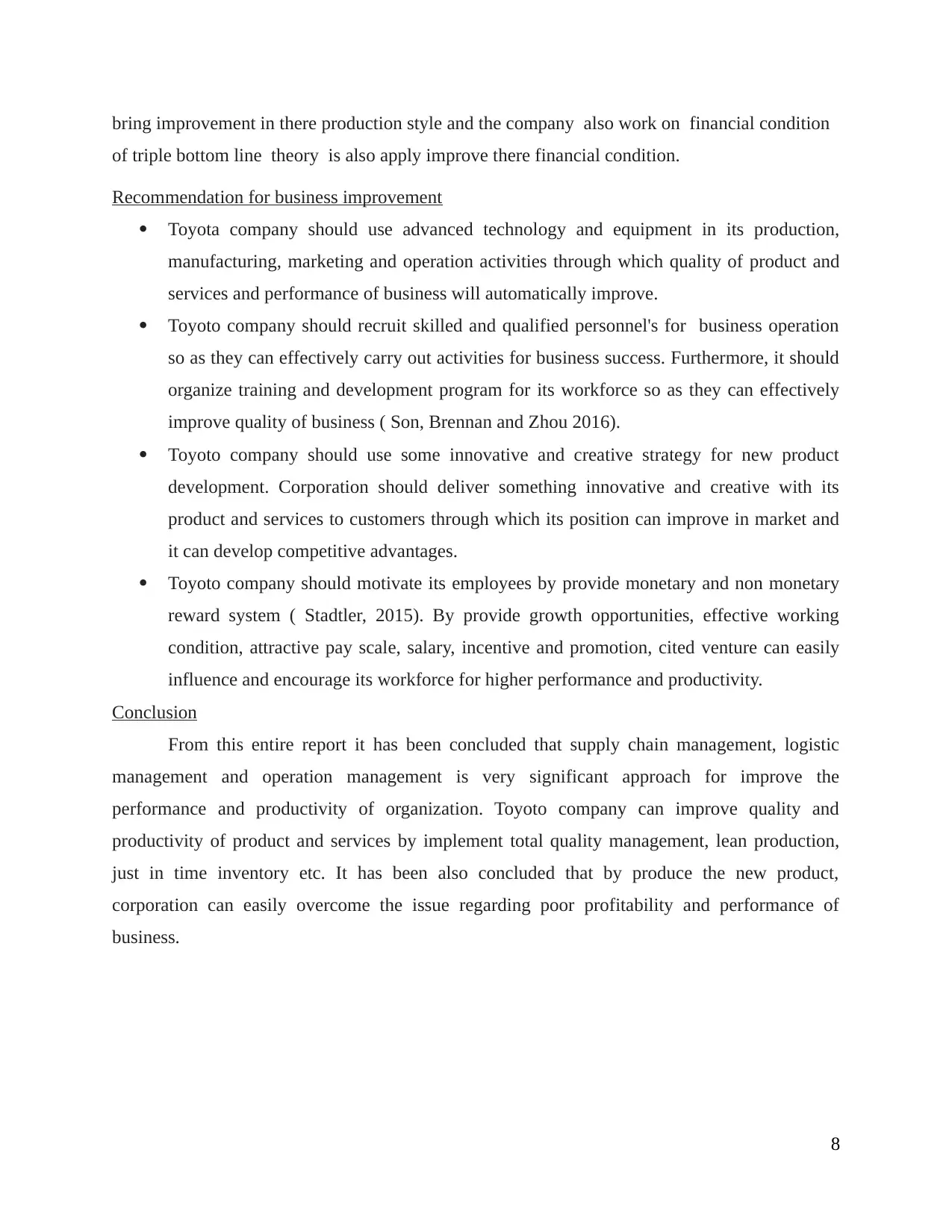
bring improvement in there production style and the company also work on financial condition
of triple bottom line theory is also apply improve there financial condition.
Recommendation for business improvement
Toyota company should use advanced technology and equipment in its production,
manufacturing, marketing and operation activities through which quality of product and
services and performance of business will automatically improve.
Toyoto company should recruit skilled and qualified personnel's for business operation
so as they can effectively carry out activities for business success. Furthermore, it should
organize training and development program for its workforce so as they can effectively
improve quality of business ( Son, Brennan and Zhou 2016).
Toyoto company should use some innovative and creative strategy for new product
development. Corporation should deliver something innovative and creative with its
product and services to customers through which its position can improve in market and
it can develop competitive advantages.
Toyoto company should motivate its employees by provide monetary and non monetary
reward system ( Stadtler, 2015). By provide growth opportunities, effective working
condition, attractive pay scale, salary, incentive and promotion, cited venture can easily
influence and encourage its workforce for higher performance and productivity.
Conclusion
From this entire report it has been concluded that supply chain management, logistic
management and operation management is very significant approach for improve the
performance and productivity of organization. Toyoto company can improve quality and
productivity of product and services by implement total quality management, lean production,
just in time inventory etc. It has been also concluded that by produce the new product,
corporation can easily overcome the issue regarding poor profitability and performance of
business.
8
of triple bottom line theory is also apply improve there financial condition.
Recommendation for business improvement
Toyota company should use advanced technology and equipment in its production,
manufacturing, marketing and operation activities through which quality of product and
services and performance of business will automatically improve.
Toyoto company should recruit skilled and qualified personnel's for business operation
so as they can effectively carry out activities for business success. Furthermore, it should
organize training and development program for its workforce so as they can effectively
improve quality of business ( Son, Brennan and Zhou 2016).
Toyoto company should use some innovative and creative strategy for new product
development. Corporation should deliver something innovative and creative with its
product and services to customers through which its position can improve in market and
it can develop competitive advantages.
Toyoto company should motivate its employees by provide monetary and non monetary
reward system ( Stadtler, 2015). By provide growth opportunities, effective working
condition, attractive pay scale, salary, incentive and promotion, cited venture can easily
influence and encourage its workforce for higher performance and productivity.
Conclusion
From this entire report it has been concluded that supply chain management, logistic
management and operation management is very significant approach for improve the
performance and productivity of organization. Toyoto company can improve quality and
productivity of product and services by implement total quality management, lean production,
just in time inventory etc. It has been also concluded that by produce the new product,
corporation can easily overcome the issue regarding poor profitability and performance of
business.
8
Paraphrase This Document
Need a fresh take? Get an instant paraphrase of this document with our AI Paraphraser
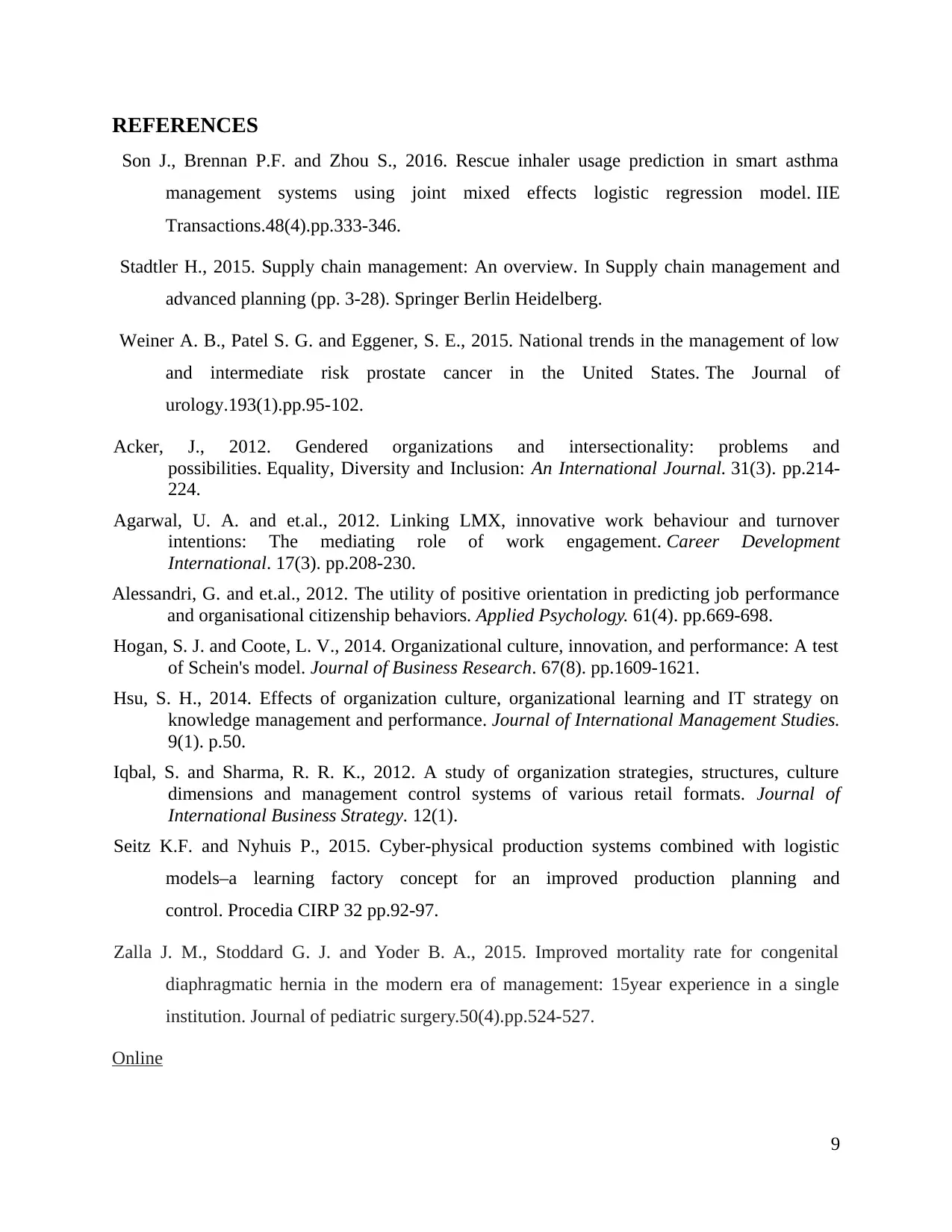
REFERENCES
Son J., Brennan P.F. and Zhou S., 2016. Rescue inhaler usage prediction in smart asthma
management systems using joint mixed effects logistic regression model. IIE
Transactions.48(4).pp.333-346.
Stadtler H., 2015. Supply chain management: An overview. In Supply chain management and
advanced planning (pp. 3-28). Springer Berlin Heidelberg.
Weiner A. B., Patel S. G. and Eggener, S. E., 2015. National trends in the management of low
and intermediate risk prostate cancer in the United States. The Journal of
urology.193(1).pp.95-102.
Acker, J., 2012. Gendered organizations and intersectionality: problems and
possibilities. Equality, Diversity and Inclusion: An International Journal. 31(3). pp.214-
224.
Agarwal, U. A. and et.al., 2012. Linking LMX, innovative work behaviour and turnover
intentions: The mediating role of work engagement. Career Development
International. 17(3). pp.208-230.
Alessandri, G. and et.al., 2012. The utility of positive orientation in predicting job performance
and organisational citizenship behaviors. Applied Psychology. 61(4). pp.669-698.
Hogan, S. J. and Coote, L. V., 2014. Organizational culture, innovation, and performance: A test
of Schein's model. Journal of Business Research. 67(8). pp.1609-1621.
Hsu, S. H., 2014. Effects of organization culture, organizational learning and IT strategy on
knowledge management and performance. Journal of International Management Studies.
9(1). p.50.
Iqbal, S. and Sharma, R. R. K., 2012. A study of organization strategies, structures, culture
dimensions and management control systems of various retail formats. Journal of
International Business Strategy. 12(1).
Seitz K.F. and Nyhuis P., 2015. Cyber-physical production systems combined with logistic
models–a learning factory concept for an improved production planning and
control. Procedia CIRP 32 pp.92-97.
Zalla J. M., Stoddard G. J. and Yoder B. A., 2015. Improved mortality rate for congenital
diaphragmatic hernia in the modern era of management: 15year experience in a single
institution. Journal of pediatric surgery.50(4).pp.524-527.
Online
9
Son J., Brennan P.F. and Zhou S., 2016. Rescue inhaler usage prediction in smart asthma
management systems using joint mixed effects logistic regression model. IIE
Transactions.48(4).pp.333-346.
Stadtler H., 2015. Supply chain management: An overview. In Supply chain management and
advanced planning (pp. 3-28). Springer Berlin Heidelberg.
Weiner A. B., Patel S. G. and Eggener, S. E., 2015. National trends in the management of low
and intermediate risk prostate cancer in the United States. The Journal of
urology.193(1).pp.95-102.
Acker, J., 2012. Gendered organizations and intersectionality: problems and
possibilities. Equality, Diversity and Inclusion: An International Journal. 31(3). pp.214-
224.
Agarwal, U. A. and et.al., 2012. Linking LMX, innovative work behaviour and turnover
intentions: The mediating role of work engagement. Career Development
International. 17(3). pp.208-230.
Alessandri, G. and et.al., 2012. The utility of positive orientation in predicting job performance
and organisational citizenship behaviors. Applied Psychology. 61(4). pp.669-698.
Hogan, S. J. and Coote, L. V., 2014. Organizational culture, innovation, and performance: A test
of Schein's model. Journal of Business Research. 67(8). pp.1609-1621.
Hsu, S. H., 2014. Effects of organization culture, organizational learning and IT strategy on
knowledge management and performance. Journal of International Management Studies.
9(1). p.50.
Iqbal, S. and Sharma, R. R. K., 2012. A study of organization strategies, structures, culture
dimensions and management control systems of various retail formats. Journal of
International Business Strategy. 12(1).
Seitz K.F. and Nyhuis P., 2015. Cyber-physical production systems combined with logistic
models–a learning factory concept for an improved production planning and
control. Procedia CIRP 32 pp.92-97.
Zalla J. M., Stoddard G. J. and Yoder B. A., 2015. Improved mortality rate for congenital
diaphragmatic hernia in the modern era of management: 15year experience in a single
institution. Journal of pediatric surgery.50(4).pp.524-527.
Online
9

New Product Development. 2017.{Online]. Available
through.<http://decision-point.net/services/new-product-development/>
10
through.<http://decision-point.net/services/new-product-development/>
10
⊘ This is a preview!⊘
Do you want full access?
Subscribe today to unlock all pages.

Trusted by 1+ million students worldwide
1 out of 12
Related Documents
Your All-in-One AI-Powered Toolkit for Academic Success.
+13062052269
info@desklib.com
Available 24*7 on WhatsApp / Email
![[object Object]](/_next/static/media/star-bottom.7253800d.svg)
Unlock your academic potential
Copyright © 2020–2025 A2Z Services. All Rights Reserved. Developed and managed by ZUCOL.




